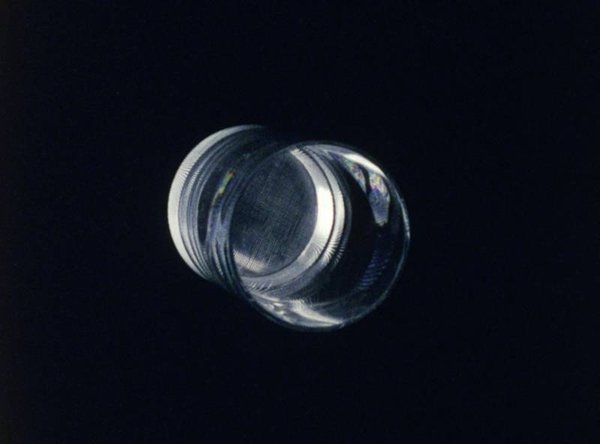28/1/2010
Mathias Poledna
Portikus, Frankfurt
An exhibition featuring the work of the Los Angeles-based artist. The show marks the first time this new filmic spatial installation is shown to the public by itself. The point of departure for Poledna's work is a crystal glassware set designed by Adolf Loos (1870-1933) and first manufactured in 1929 by the Viennese glassmakers L&J Lobmeyr.

The Portikus in Frankfurt is proud to present an exhibition featuring the work of the Los Angeles-based artist
Mathias Poledna (b. Vienna, 1965). The exhibition marks the first time this new filmic spatial installation is
shown to the public by itself.
The point of departure for Poledna’s work is a crystal glassware set designed by Adolf Loos (1870–1933) and
first manufactured in 1929 by the Viennese glassmakers L&J Lobmeyr. The so-called “bar set” consists of
twelve individual pieces: a fingerbowl, a champagne flute, a beer glass, a wine decanter, a water pitcher, a water
glass, a double Old Fashioned whiskey tumbler, and red wine, white wine, dessert wine, sherry, and liqueur
glasses. In contradistinction to traditional glass services of the era, whose individual pieces are usually quite
different, each adapted to its particular purpose, and typically adorned with highly detailed decorations, all
pieces in Loos’s bar set are based on a single highly reduced basic shape: a fully rounded glass with a flat bottom
and sides at a right angle to the floor.
The service’s individual components can be understood as “variations” on
this motif; their shapes are adapted to their intended purposes, but differences between them are limited to the
exact ratio between the height and the diameter of a glass. Loos realizes his philosophical ideas about the
progress of culture in the simplicity and precision of the bar set’s formal design. Yet unlike other comparable
approaches to design of the same era, Loos combines formal reductionism and the absence of all ornamentation
with the utmost refinement in the use of the material and the execution.
The bottoms of these mouth-blown
glasses, which are ground and polished by hand, bear diamond-cut facets, a fine-grained grid-like pattern that
creates the subtlest scintillation. It would be difficult, however, to recognize this cultural-historical background
in the work itself; to the contrary, it has been, as it were, compartmentalized, removed from the filmic
representation and replaced by a spatial narrative of transparency, texture, absence, and motion. In the interplay
between typological recording, detail shot, and shifting dramaturgy, this representation aims at a sort of
choreography of objects that explores boundaries and transitions between abstraction, historical documentation,
and the hyperaesthetic mise-en-scène of a commercial product.
Exhibitions (solo): 2009: Bonner Kunstverein, Bonn (with Christopher Williams); New Museum of
Contemporary Art, New York; 2007: Galerie Daniel Buchholz, Cologne; Hammer Museum, Los Angeles; 2006:
Witte de With Center for Contemporary Art, Rotterdam; Galerie Daniel Buchholz, Cologne; 2005: Richard
Telles Fine Art, Los Angeles; 2004: Galerie Meyer Kainer, Vienna; 2003: Museum Moderner Kunst Stiftung
Ludwig, Wien; 2002: Richard Telles Fine Art, Los Angeles; 2001: Grazer Kunstverein.
Group exhibitions (selection): 2010: Modernologies, Warsaw Museum of Modern Art, Warsaw; 2009:
Modernologies, Museu d’Art Contemporani de Barcelona, Barcelona; See This Sound, Lentos Kunstmuseum
Linz; Rock—Paper—Scissors: Pop Music as the Subject in Contemporary Art, Kunsthaus Graz; Memories of
the Future, Galerie Václava Spály, Prague; 2008: Yokohama Triennial, Yokohama, Japan; Transes, Musée
départemental d’art contemporain, Rochechouart; 2007: Collection, Generali Foundation, Vienna; Perspektive
07, Lenbachhaus, Munich; How Soon is Now, Fundació Luís Seoane, La Coruña; Archaeologies of the Future,
Sala Rekalde, Bilbao; 2006: Whitney Biennial 2006: Day for Night, Whitney Museum of American Art, New
York; Why Pictures Now, Museum Moderner Kunst Stiftung Ludwig, Vienna; Galerie Daniel Buchholz,
Cologne, Metro Pictures, New York; 2005: Occupying Space. Collection Generali Foundation, Haus der Kunst,
Munich; I really should ..., Lisson Gallery, London; 2004: Liverpool Biennial 2004, Tate Liverpool; 20/20
Vision, Stedelijk Museum, Amsterdam; 3rd Berlin Biennial for Contemporary Art, Kunstwerke Berlin; 2003:
Mixtapes, CCAC Wattis Institute for Contemporary Art, San Francisco; Adorno. Die Möglichkeit des
Press conversation 29 January 2010 at 11 am
Lecture: 1/27/2010, 7 pm, Städelschule, auditorium
Opening 29 January 2010, 8 pm
Portikus
Alte Brucke 2 (Maininsel), Frankfurt



